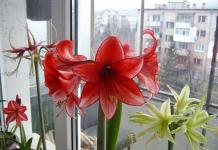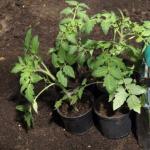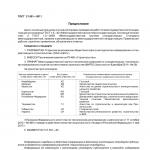Tomato seedlings are planted in open ground early May, the next stage is transplanting seedlings under a film shelter (May 15 - 25). You can shoot the film after the establishment of stable good weather and high air temperature. For different varieties of tomatoes, the terms may differ slightly, but not more than 14 days.
Seedling appearance
Before planting tomatoes in open ground, seedlings must gain enough strength and adapt to the climatic conditions in which the growing season will continue. The readiness of seedlings can be judged by the length of the stem and the number of true leaves. By the time of transfer to open ground the stem should reach 25-30 cm in length and have 6-7 true leaves, as well as one flower brush, but the flower brush does not always appear.

Depending on the climate
More stable seedlings can be planted in the tenth of May, but such decisions must be made taking into account the climatic features of the growing region. If there is a tendency for frosts in the corresponding region in the middle or early May, then it is better to wait until the twentieth or even the thirtieth.
Moon calendar
The lunar cycle lasts 29.5 days, hence the discrepancies with the generally accepted calendar and recommendations for planting seedlings. All of them are based on the assertion that different phases of the moon have different effects on the environment and plant growth as well. It is believed that during the new moon, full moon, the first and last quarters of the Moon, the Sun and the Moon interact with each other in a special way, which is negatively reflected in all the affairs started during this period.
A favorable time for planting plants and for other undertakings in general is the phase of the growing (young) moon. Young Moon - the phase following the new moon, takes a total of 11 days in a month, alternating and interrupted by other phases. For example, The lunar calendar for May 2017 looks like this:
- 1–4.05.17 - Growing moon;
- 05/06–11/17 - Growing moon;
- 05/13–19/17 - waning moon;
- 05/21–27/17 - waning moon;
- 05/29–31/17 - growing moon (new, young).
That is, if you decide to plant your garden, guided by the lunar calendar, you will have to take into account two factors: the phase of the moon and which of the signs of the zodiac it is in. Libra, Taurus, Capricorn, Pisces, Cancer and Scorpio are considered fertile signs, while Aries, Virgo, Gemini and Leo are considered barren.
When you are planning to plant tomatoes in open ground, make sure that the seedlings have been properly prepared. 2-3 weeks before planting, reduce the amount of incoming moisture and gradually reduce the temperature. To begin with, the temperature is lowered by 3-5 degrees and the air circulation in the room is improved. 5-7 days before planting, watering is stopped altogether.
Reducing watering helps to control the growth of seedlings, which, with an abundance of moisture, can easily reach a meter in height before planting. In addition, the lack of moisture will provoke its increased absorption and a strong push for vegetation, when the plant, in the end, will receive it. But be careful: yellowed leaves or stems that have partially lost turgor indicate that the seedlings suffer from an acute moisture deficiency and need a “sip of water”.

Weather
Ideally, if it rained before the day of planting and the ground is quite wet, but we are not able to create suitable weather conditions, we will start from the calendar dates. It is necessary to start planting tomatoes in open ground after about 17:00, when solar activity has subsided. Tomatoes need time to root and an extra 24 hours before the next sun is a good head start.
If you plant seedlings in the morning, the seedlings may wither, as the root system damaged during transplantation will not have time to recover and will not be able to absorb moisture from the soil for some more time. Speaking of soil temperature, it should be warm enough. To do this, the air temperature must be kept above 17 ° for at least seven days.
Place to land
Tomatoes are very thermophilic plants, therefore, when choosing a place for their landing, the criterion of access to the sun should be one of the leading ones. The soil on which tomatoes will grow must be loose and fertile.
Chernozems would be ideal, but good yields can also be harvested from peaty soils. Clay and loamy soils are not suitable at all, sandy soils are well breathable, but need generous annual fertilizer.

Landing scheme
As with many other aspects of planting and caring for crops, tomato planting is a deliberate process with no random or arbitrary components. Distance between rows, bushes and hole depth depends on growing region, varieties of tomatoes and the size of seedlings at the time of planting. In regions with high humidity, the distance between seedlings should be greater than in dry ones.
More space means better ventilation and better reach of the sun's rays. Good access to air and heat is the best prevention of fungal diseases such as powdery mildew or. This scheme is used mainly in the forest-steppe zone.
In arid regions, on the contrary, the bushes are located as close to each other as possible to prevent the soil from drying out and retain more moisture. The scheme is suitable for the steppe and forest-steppe zones. Planting scheme - depending on the height of the seedlings. It is logical that the larger the plant, the more space it will need.

Here are some proportions for tall, medium and short tomatoes:
- Tall varieties. The height of the bush is more than 150 cm. Planted at a distance of 80-100 / 50-60 cm, where 80-100 is the distance between the rows, and 50-60 is the distance between the bushes.
- Medium varieties. The height of the bush is less than 150 cm (100 cm on average). Planted at a distance of 70-80 / 45-50 cm.
- Undersized varieties. The height of the bush is from 30 to 100 cm. Planted at the rate of 60-70 cm - aisle, 20-40 cm - between the bushes.
- Dwarf varieties. Very small tomatoes, the height of the bush does not exceed 30-40 cm. They are planted according to a special hole system. With the hole method, 2 bushes are placed in one hole at a distance of about 10 cm. 50 cm are kept between rows, and 30 cm between holes.
Technology
Compliance with the conditions for planting tomatoes in open ground will require significant efforts from the farmer. This is a complex process with many components and requires special equipment, but the methods taken will allow you to get a good result.
To speed up the emergence of a good and high-quality crop, most vegetable crops today are grown from seedlings.
It begins to be grown a few weeks or months before planting in a permanent place where the crop grows.
In this material, we would like to discuss in more detail when it is best to plant seedlings of the most popular vegetables now grown in almost every summer cottage - this tomatoes, peppers, cucumbers, cabbage, eggplant and zucchini.
In recent years, it has become popular to plant seedlings according to the ray calendar or according to various folk signs.
It is believed that plants planted on the waning moon will be lifeless and weak. But we will consider more rational planting dates, based on the characteristics of each of the plants.
Modern gardeners grow seedlings in a variety of ways. Special pots, egg trays and even paper cups are used for this. The time of planting seeds depends entirely on the types and individual characteristics of the growth of vegetables. The main thing to consider is the approximate time for planting cuttings in open ground in a permanent place.
They begin to grow seedlings, often from April, early May. Moreover, in May it can be grown directly in open ground under shelters made of a special film, of course, if the year is warm. A few weeks before transplanting, plants from warmed places are often hardened, that is, they are taken out a little to the open space of the street, each time increasing the length of stay in cooler conditions.
Planting pepper seedlings
Pepper is a very heat-loving crop, which is considered one of the most beneficial for the human body. It contains a huge amount of vitamin C and multivitamin A. Sweet pepper perfectly complements many meat dishes on our table, so summer residents grow it in their gardens.

Photo of seedlings of pepper
Peppers are suitable exclusively for seedling cultivation., since the time from germination to the appearance of the first fruits is quite long - 120-150 days. Peppers are transplanted into open ground at the age of 60-80 days, when the first buds appear on the bush. Approximate landing time is determined by ambient temperature.
Having started the first shoots, the plant grows well at a temperature of 12 to 15 degrees during the day, and from 6 to 10 at night. Therefore, the approximate planting time is the first decade of June, when the risk of frost is minimal. During the period of seedling maturation in greenhouses, it needs periodic solar hardening, since plants that do not see the sun will immediately burn out.
tomato seedling
Tomatoes are a round red vegetable with a sweet or sweet and sour flavor. Of all vegetable crops, tomatoes are the least demanding in growing conditions. But they are quite demanding on the temperature regime.

Photo of tomato seedlings
The first shoots are shown in the ground as early as 3-7 days after sowing. The optimum temperature for the normal development of tomatoes is 20-25 degrees. If the temperature rises above 30, then their growth slows down significantly or stops altogether.
Planting tomatoes for seedlings should be approximately 60-70 days before transplanting to a permanent place. Late varieties are planted in 45-50 days. The time for sowing seeds is March 10 - April 1. As a rule, young plants are transplanted after the spring frosts have ended.
For the central regions of the country - this is May 1-15, more northern regions - June 10-20. If the seedlings were previously hardened, then transplantation can be done 15-20 days earlier than the generally accepted dates.
cucumber seedling
Cucumbers are the most capricious vegetable in terms of transplantation. Before planting the seeds of a plant, they need to be germinated. In the twentieth of March - early April, you can start preparing seedlings.

Before sowing, the seeds are soaked in a solution of potassium permanganate (2 g per 250 g of water). Then they are moved to a damp cloth, which maintains a temperature of 20-25 degrees. When they have the first seedlings, they begin to plant plants in pots, 6-10 cm wide.
The maximum age of a young plant before transplantation is 25-30 days. In the greenhouse, transplantation begins in mid-May, and on open ground - in mid-June.
Seedlings of zucchini and eggplant
These crops, like cucumbers, are very whimsical to grow. The temperature of their normal development is 20-25 degrees. The first shoots of plants appear after 10-15 days after sowing.

In the photo, eggplant seedlings
If the temperature drops, then seedlings may appear much later. Early maturing varieties of zucchini bear fruit only 100 days after planting, which is why they are grown through seedlings.
Plants are transplanted into the ground, usually 60-65 days after sowing the seeds. The plant does not tolerate frost, so it is better to plant eggplant seedlings in mid-March, and transfer them to the ground at the end of May.
Sowing time for cabbage
Cabbage seeds are sown at a variety of times, it all depends on the variety of the crop. But usually this happens 60-65 days before transplanting into open ground. Seedlings of cabbage of earlier varieties can be started as early as mid-March, medium and late - from mid-April.

The first harvest in early varieties occurs after 90-110 days, in medium - 130-150 days, while late varieties bear fruit 150-170 days after planting.
This plant is cold-resistant and photophilous, and has special requirements for soil fertility. Seedlings develop normally at a temperature of 6 to 10 degrees until the first shoots appear, then the temperature should be increased to 14-18 degrees.
Planting dates for seedlings are different for each plant. Therefore, before starting it, study the characteristics of the growth of the crop in order to get a rich and healthy harvest on time.
For experienced gardeners, and even for "green" beginners, there is no secret when it is best to plant seedlings. Anyone will say that you need to remember about the timing of sowing pepper already in the middle of winter, and with tomatoes it is better to wait until the first spring days. This, of course, is true, but if you dig a little deeper, it turns out that every summer resident has his own little “know-how” about when to plant seeds for seedlings. Although, if you look, they all obey the same rules of agricultural technology. Which one exactly? Let's figure it out together.
When the coveted bags with the future harvest are laid out on the table, I really want to immediately put it all into the ground and start caring as soon as possible. But stop! Everything together is impossible in any way, because every self-respecting amateur knows that far from all crops can be sown for seedlings at the same time.
Why? - the amateur will ask already. Because the timing of planting seeds for seedlings depends on at least 5 conditions:
- How long does it take to germinate a seed.
- What is the length of the growing season.
- At what age is the plant ready for transplanting into the ground.
- Where the culture will grow: in the open field, greenhouse or greenhouse.
- When is the first harvest planned?
On a note! In addition, it is worth considering the climatic conditions of the region of residence and how thermophilic our “green friend” is.
Having collected all the data in a kind of pivot table (for some it’s enough to do it in their head, but for someone it’s more reliable on paper), it’s not difficult to calculate up to the day when it’s time to sow seeds for seedlings. Most of the data is indicated directly on the package, and the Internet will tell you the rest.
Each vegetable has its time
From the foregoing, it is clear that the timing for planting seedlings of cabbage or, for example, tomatoes, differs not because the cabbage is green, but the tomato is red. Their varietal characteristics are the main reason for the different sowing schedules.
What should be focused on when planting specific crops?
About tomatoes
The spread of planting cycles for this vegetable is very large. After all, there are an extraordinary variety of hybrid varieties today, and for each time, it is determined differently. In general terms, the periods can be systematized as follows:
- Early March: large varieties.
- The second half of March: early varieties for soil under the film, tall for greenhouses.
- From the beginning to the middle of April: early and undersized tomatoes for greenhouses.

Inexperienced gardeners, reinsured, begin to spread the seeds into pots, Towhen to sow tomatoes for seedlings still too early: almost from the beginning of February. Of course, this is not unusual for residents of the Krasnodar Territory.
But for central Russia the middle of winter is absolutely not suitable. After all, mature plants will have to languish on the hot window sills of city apartments for an extra 1-1.5 months. And then the "pickled" bushes will go to the dachas. And what will happen to them?
What about cabbage?
 Determine as accurately as possible when to sow cabbage for seedlings, can also be done with simple calculations. The initial figures are again taken from the bags, and the period of 45-60 days is taken as the basis. This is how much, on average, it takes for an ascended seed to prepare for transplantation.
Determine as accurately as possible when to sow cabbage for seedlings, can also be done with simple calculations. The initial figures are again taken from the bags, and the period of 45-60 days is taken as the basis. This is how much, on average, it takes for an ascended seed to prepare for transplantation.
Early hybrids are sown during March, medium - from its second half to the 20th of April. Before the beginning of May, it is necessary to sow all the cabbage.
According to the old folk way, strong plants grow if you sow the seeds in a moist bed in the open ground, as soon as the snow has melted. Such cabbage will rise in time and harden naturally.
Sowing cucumbers
With deadlines When to plant cucumber seedlings everything is simple. In central Russia, cucumber bushes go to greenhouses around April 20, and to open beds (sometimes under a film) - by mid-May. Since the plant reaches the required phase of three leaves 3-4 weeks after sowing, it becomes clear when planting cucumber seedlings.
It turns out that the optimal time for sowing cucumber seeds for seedlings for greenhouses will be mid-late March, and mid-late April for open ground.
When to plant seeds for seedlings: Pepper is next
A lot of controversy goes around the topic when to sow pepper for seedlings. The fact is that, unlike other vegetables, this culture sprouts much more slowly. Sometimes it takes almost a month for the seeds to germinate, and inexperienced gardeners start to sow the pots out of fright.
In fact, you just need to be patient, because the sprouted seedlings begin to quickly gain strength and catch up with other crops.

In this scenario, it is easy to calculate Towhen to plant pepper seedlings: the period from mid-February to the 10th of March is much more favorable. Seeds should be immediately planted in separate pots, as pepper bushes do not like to be disturbed.
By the way, if you use method of planting peppers with boiling water , then the shoots will not keep you waiting! Do not believe it, but all your peppers will rise on the 3rd day. It is checked up on own experience.
Eggplants are sown
When to plant eggplant seedlings depends on where they will grow during the summer. The culture sits on the bed at the age of 70-80 days, this figure should be taken for calculations. For greenhouse cultivation, transplantation to a permanent place takes place at the end of April, which means that sowing must be completed before February 10.
If eggplants grow in the garden, the planting dates will be postponed to the first decade of June. Accordingly, the seeds are laid in the soil from March 10 to 20.

For watermelons to sing together
Even in the middle lane, weather conditions rarely reach the optimum for growing gourds. Therefore, with the timing when planting watermelons for seedlings, one must not miscalculate. Ready-made bushes with 3-5 leaves can be planted exclusively in well-warmed, awakened soil. If you risk growing melons in a seedless way, then it will only come to flowers.
On a note! Strong healthy seedlings will be obtained from seeds sown in early April. In a month they will have time to take root and gain strength. Then the seedlings can be safely sent to the beds.
Sowing dates for seedlings
A big rush has been coming to gardeners since the end of January. Buy seeds, sort out last year's stocks, prepare seedling boxes - it's not surprising to miss out on the fuss,. To prevent this from happening, we have prepared a special reminder table. It contains all the optimal periods for planting seeds.

It should be noted that the climatic conditions of the middle part of Russia are taken as a basis. For other zones, the data must be corrected.
Video: When to sow seeds for seedlings - advice from an experienced gardener Valery Medvedev, proven over many years of practice
Another 500 articles on the channel of the same name in Yandex Zen . It is with great pleasure that we invite you to visit
An attempt to grow planting material on your own is not always successful, and then there is only one way out - to buy. We will tell you where and how to choose the right young plants of tomatoes, peppers and cabbage, how to prepare the soil and how to plant seedlings.
How to choose seedlings
From how correctly you choose the seedlings of vegetables, their future harvest depends. Weak, overgrown or, conversely, insufficiently grown plants are poorly accepted, “sick” for a long time and as a result produce about 30% less vegetables than those that were planted in the ground strong and healthy. Therefore, when buying seedlings, adhere to the following recommendations:
- the best place to buy is a nursery. There, vegetable crops are grown under the same conditions and with the observance of technology, and therefore they are more viable than their counterparts cherished by amateur gardeners;
- give preference to plants sold in separate containers: peat pots, cups, etc., that is, those that have a lump of "native" land. They take root more easily in the new soil, and you can be sure that their root system is not damaged. If it is not possible to buy seedlings in a container, then look for one whose roots are maximally protected from sunlight and weathering (for example, sealed in bags with lumps of moist earth);
- don't buy overgrowths. They have minimal chances of surviving in the open field, and they bear fruit much worse. Seedlings of tomatoes should have 8 leaves, cucumbers - 4-6, cabbage - 4;
- withered seedlings are characterized by low viability, so choose only fresh ones with a developed root system and strong stems. Remember: the longer the plant is out of its usual environment - the soil, the less likely it is to survive and bring a good harvest;

- keep in mind that spots and light veins on the leaves are signs of disease.
And now about some features of each vegetable.
- Healthy cabbage seedlings has glossy light green leaves with a bluish bloom. According to their outlines, they determine what kind of cabbage head will be in the future. If the leaves are round, then the head will look like a ball, oval foliage guarantees an elongated head shape. Choose cabbages with stems that have a purple hue. Such cabbage seedlings are hardened and able to withstand even at low temperatures.
- Good pepper seedlings have leaves of different colors: the upper ones should be slightly lighter than the lower ones. If they try to sell you plants with the same colored foliage, they were most likely grown with growth accelerators and growth retarders. Such seedlings will not take root well and will be of low yield, and therefore there is no point in planting it. Avoid plants with flowers. Pepper seedlings are very whimsical and do not tolerate transplantation very well, during which they can “throw off” flowers.
- A strong stem and light green leaves are signs of healthy tomato seedlings. Be sure to pay attention to the cotyledon knee (the distance from the root to the first lower leaves): the smaller it is, the stronger the plant. Tomato seedlings with dark green leaves should alert you. This is usually a sign of too much nitrogen. Plant growth was artificially stimulated, and in the case of seedlings, the consequences of such actions will lead to a low yield.

For the transportation of seedlings, it is better to use a rigid container, choosing its dimensions depending on the width and height of the plants. It can be a plastic vegetable box or a shallow bucket. Such transportation will help to avoid squeezing and damaging the seedlings.
How you are being deceived: tricks of sellers
In pursuit of profit, some sellers resort to not entirely honest ways to sell seedlings.
Stimulate and slow down
To accelerate the growth of a vegetable crop, it is "stuffed" with nitrogen-containing fertilizers. When there is a danger of being left on hand with an "overstark", inhibitors are used - growth retarders. It is impossible to plant seedlings grown in this way, since a violation of technology leads to a decrease in yield. Unfortunately, it is almost impossible to determine such a violation of technology by a plant.
There is only one way out - to buy seedlings in a nursery, where the cultivation process is strictly monitored.
Fedot, but not the one
There is also a “fashion” for vegetable seedlings. The rumor that one of the varieties of cucumbers or tomatoes gives innumerable yields creates an increased demand for it. Sellers play on this by selling other, less popular varieties under the guise of a super-prolific variety of vegetables.

Not every agronomist can determine the variety by the configuration of the leaves, but an ordinary amateur gardener, and even more so. Therefore, seedlings of tomatoes, peppers, cucumbers and other garden vegetation should be bought in places and from trusted sellers. This may be a nursery, a neighbor who sowed the seeds herself and received a surplus, as well as a specialized store.
Doomed in advance
Seedlings of cucumbers, squash and zucchini do not tolerate transplanting well, and even if they take root, they will never give a good harvest. You shouldn't buy it. These vegetable crops grow well in open ground from seeds. Are you afraid of frost? Make a greenhouse for cucumbers, and cover the holes with squash and zucchini with insulation.
These tips will come in handy if you decide to start growing vegetables and become a farmer.
Preparing the soil for planting seedlings
Before plant seedlings into the ground, prepare the soil. We advise you to start in the fall: having decided on a place, dig the soil there to a depth into the bayonet of a shovel. Leave clods of earth unground, so it will freeze better, which will kill most of the larvae of garden pests.
Some gardeners advise disinfecting the soil in the spring by watering it with a solution of copper sulfate heated to 80 ° C (1 tablespoon of copper sulfate per 10 liters of water). It is believed that in this way the likelihood of seedling disease is minimized. However, by killing harmful microorganisms, vitriol destroys useful ones, and therefore decide for yourself whether it is worth using it.

But fertilizing the ground before planting seedlings will not hurt. About a month before planting, sprinkle evenly over the garden:
- organic fertilizers - manure (3 kg per 1 m²), wood ash (1 glass per 1 m²);
- mineral fertilizers - superphosphate (1 tablespoon per 1 m²), potassium sulfate (1 tablespoon per 1 m²).
Then dig and level with a rake, carefully breaking up clods of earth.
When and how to plant seedlings in the ground
You need to plant seedlings in the ground on the day of purchase, but you should take into account weather. If weather forecasters promise a cloudy day, it is better to plant the plants right in the morning. But with a sunny weather forecast, we advise you to wait until the evening, then during the night your "settlers" will be able to at least partially take root.
Planting seedlings in different regions takes place at different times. We will provide a table that reflects the optimal timing for central Russia, as well as the distances between holes and rows, which we recommend that you follow.

Planting seedlings in the southern regions of the Russian Federation and in Ukraine is carried out a couple of weeks earlier.
Having learned when to plant seedlings, let's figure out how to plant them. Here is a step-by-step instruction for a beginner gardener:
- Using a chopper, mark the locations of future holes. To keep the rows even, a rake laid on the ground can be used as a reference line.
- Make a hole with a hoe. Its depth depends on the height of the stem, but keep in mind: the lowest leaves of tomatoes and peppers must remain above the ground, like the cabbage growth bud, otherwise it will die.
- If the ground is dry, pour some water on the bottom of the hole, lightly sprinkle with soil (do not be afraid if you get such a swamp - this is not scary for plants).
- Holding the seedlings vertically in the hole with one hand, fill the hole with earth with the other, then press down on the soil to strengthen the root and stem.
- When the earth is dry, the newly planted plant will need to be watered, and then sprinkled with soil on this place.

This completes the landing. But you will have to make some more efforts for the seedlings to take root:
- every evening, until the plants are accepted, they need to be watered. Pour water gently under the spine. It is possible to determine that the seedlings have taken root by its equally vigorous state both in the evening and in the morning - at first during the day it may look wilted. Then proceed to watering as the earth dries;
- the sun is the enemy of transplanted plants, so on clear days the first week they need to be covered with something. There are no special devices - make paper caps or cover them in the way described in the video:
Now you know how to plant seedlings. We wish you a good harvest!
Take it, tell your friends!
Read also on our website:
show more


















